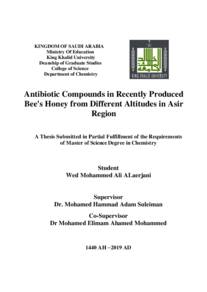Synthesis of polymeric supported magnetic nanoparticles for heavy metals removal from aqueous solution
Abstract: Different procedures were studied for removal of heavy metal from aqueous solution. Each procedure was evaluated based on its efficiency, selectivity, performance, cost and reproducibility. Many techniques were studied and developed, including adsorption, chemical precipitation, ion exchange, liquid–liquid extraction, electrodialysis and biosorption. All previous studies proved the limitations and advantages for each method. Adsorption is an important which proved certain advantages like higher efficiency, reproducibility and low cost. Chromium is a known hazardous heavy metal introduced into the ecosystem due to the discharge of chromium containing wastes. Waste streams containing chromium include mining operations, metal-plating facilities, power generation facilities, electronic device manufacturing units, and tanneries. Accumulation of Cr(VI) in human bodies causes hepatic adrenal damage, capillary damage, gastrointestinal irritation. Copper is contained in wastes of different activities, as electroplating, painting, metal finishing, electronics, fertilizer, wood industries and pigments. As some other toxic heavy metals, copper is non-biodegradable and can remain for a long time in the environmental system, which cause serious problems to living organism and human being. This thesis is meant by preparation of composite adsorbent materials based on synthesized magnetic nanoparticles (MNPs) and the copolymeri polyacrylamid-co- acrylonitrile . The magnetite nanoparticles Fe3O4 were prepared by chemical precipitation assisted by microwave, were have been added of NaOH to iron salt then dryed at 70 Co ,and supported within the co-polymer- poly(acrylamide-acrylonitrile) P(AAm-AN) by insitu polymerzition. The prepared composite P(AAm-AN)-MNPs was characterized using XRD, SEM, FT-IR, EDX-SEM and TGA. The adsorption characteristics of copper-Cu(II) and chromium-Cr(VI) were separately and studied onto P(AAm-AN)- MNPs with studying the affecting parameters as pH, contact time, metal ions concentrations, temperature and adsorbent dose. The adsorption of Cr(VI) onto P(AAmAN)- MNPs showed adsorbed amount of 2.3 mg/g at pH 4.7, 1 h of contact, 30 mg/l ion concentration and adsorbent dose of 10 g/L. While the adsorbed amount of copper-Cu(II) onto P(AAm-AN)- MNPs reached to 45 mg/g at pH 3.25, 1 h of contact, 0.01 M ion concentration and 2 g/L adsorbent dose. The adsorption isotherm models applied on the experimental results showed that the adsorption more fitted with Langmuir isotherm model. While the kinetic models showed that the adsorption fitted with pseudo-second-order kinetics. The competitive adsorption showed that the prepared composite adsorbent P(AAm-AN)-MNPs could be used as good potential adsorbent material for removal of heavy metal ions from aqueous solutions. The selectivity order for the studied metal ions based on their removalj percentage is as: Pb(II) > Cd(II) > Cu(II) > Co(II)> Ni(II) > Cr(VI) > Zn(II). The prepared composite adsorbent P(AAm-AN)-MNPs was applied for removal of heavy metal ions from real waste samples. The results clarified that the adsorbent P(AAm-AN)MNPs completely remove the present concentrations of the analy
